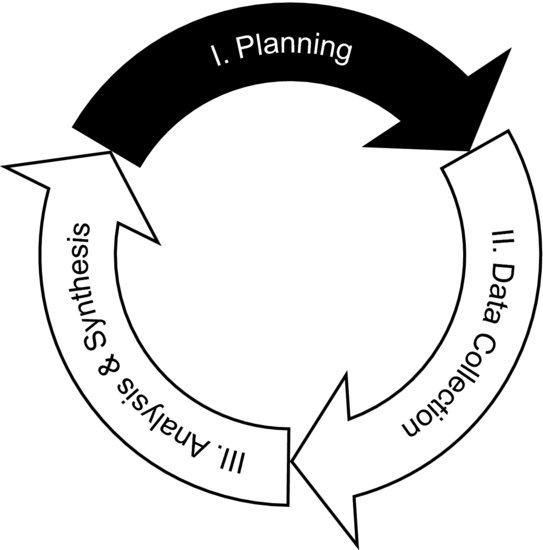10.1 The Three Phases of Research
Although individual research projects differ, they typically move through three common phases. In the first phase, a research question is formulated and a strategy is laid out for answering it. The research question is often connected to one or several hypotheses. We will call it the planning phase. Once a promising approach has been developed it is time to gather evidence to either support or refute the hypothesis. This is the data collection phase, aiming to obtain data of sufficient quality to draw robust conclusions. It involves investigating the capability of one's measurement system, in some cases even the actual development of a measurement system, as well as identifying suitable procedures for measurement. In the final stage the data are analyzed and connected back to the research question. The findings are also related to the current knowledge to define a scientific contribution. This third phase will be called analysis and synthesis. Each of the final three chapters of this book is devoted to one of these three research phases, which are schematically represented by Figure 10.1. The process is depicted as circular or periodical, since the new knowledge that results from one research activity often gives rise to new questions and new research ideas.
Figure 10.1 The three phases of research. Research is cyclic, since results from one research task often give rise to a new one.

This chapter introduces a number of tools and techniques for generating and evaluating hypotheses. Many of these tools were originally intended for solving quality problems, for example in product development organizations or production plants. In many respects, quality work is similar to research. Imagine a team of engineers that is assigned to solve a quality issue. It could be anything from a product not meeting the specifications to sudden malfunctioning, like mobile phones switching themselves off or excessive oil consumption in a car model – anything resulting in customer complaints. The team's task is to find and fix the cause of the problem as soon as possible. This can be very demanding as there are often many potential causes for such problems. They often have to consider everything from the production process to the environment where the product is used. By thinking of as many potential explanations as possible and excluding the possibilities one by one, they gradually converge on the real cause. This is very similar to what researchers do. Faced with a phenomenon that is not understood, they attempt to find potential explanations for it, and by investigating various hypotheses they approach the true scenario.
We will borrow a number of techniques from the quality toolbox. They are very simple and at first sight it might seem naïve to use them to teach scientific method. Research projects are, after all, often complex and intellectually very demanding. It should be stressed that the tools are not very interesting in themselves. They are to be seen mainly as pedagogical tools. What is interesting is the intellectual process that starts when you use them. I do not mean to imply that working scientists use these tools specifically but applying them will familiarize the reader with ways of thinking that are useful in research.
It is also important to point out that application is essential for all learning. If you explain the experience of scuba diving to a person who has grown up in a desert and has never seen the ocean, you may only convey a vague picture. To really understand what diving is like, that person must go to the ocean and experience it at first hand. The exercises in these chapters work exactly like this; they will not affect your thinking about the research process until you have experienced how they apply to problems that are relevant to you.
To make the tools less abstract I am using two real experiments as examples. One example is from biology and one from engineering, to show that the thinking applies to different fields. It should be noted that the tools were not actually applied in these experiments. They are only used as vehicles for explaining how the tools may be applied to real research problems. You may or may not use these tools in the future but when you have tested them a couple of times you should have obtained a more intuitive understanding of some important aspects of the scientific process.
Before we discuss the techniques, let us take a look at the experiments that we are going to follow over the last few chapters.
